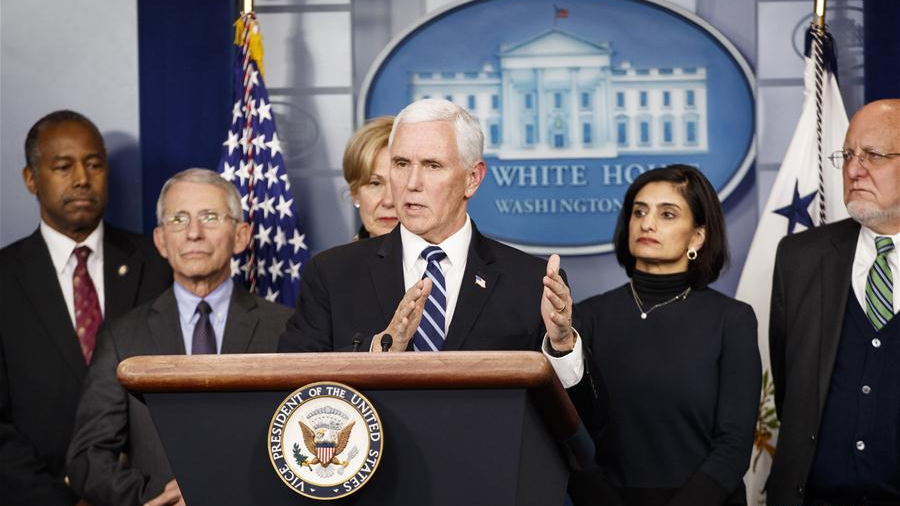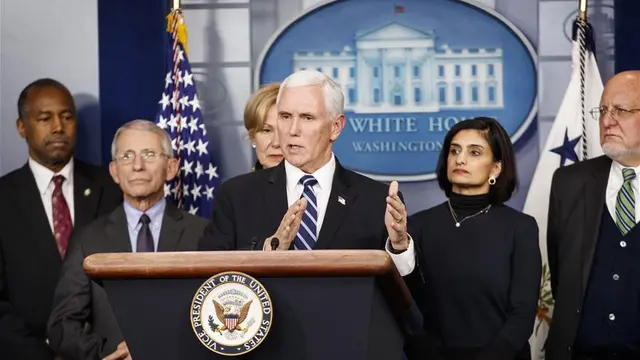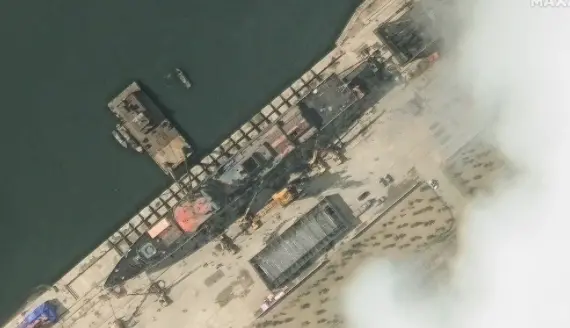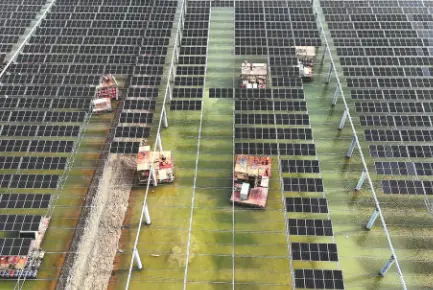
U.S. Vice President Mike Pence (front) along with members of the Coronavirus Task Force attend a press conference on the coronavirus at the White House in Washington D.C., U.S., March 4, 2020. /Xinhua
**Editor's note: **The following article is taken from the Chinese-language opinion column "TheReal Point."
As the number of daily new COVID-19 cases continues to go down in China, the virus is spreading quickly in the United States.
As of 9:00 p.m. on Tuesday, there were about 1,000 confirmed cases, including 31 deaths, in up to 40 states.At least 10 states have declared a state of emergency. U.S. medical experts have been criticizing the authorities for their slow and insufficient response to the spread of the new coronavirus with regard to data release, medical supplies and emergency resource distribution.
As to the issue of how many test kits are available in the United States, the Food and Drug Administration and the Public Health Service in the Department of Health and Human Services have come up with numbers that differ greatly from each other. The two parties of Congress spent days trading verbal jabs over how much money should be allocated to combat the outbreak.
Matt McCarthy, a staff physician at New York-Presbyterian Hospital, one of the largest and most comprehensive hospitals in the country, complained about having no access to test kits and having to "plead to test people." And the recent decision by the Centers for Disease Control and Prevention to drop COVID-19 testing numbers from its website has sparked controversy among the public.
When comparing what has been done to contain the COVID-19 virus in the U.S. and in China, William Haseltine, chair of the global health think tank ACCESS Health International, said "It's a sad day when China is outperforming the U.S. in terms of public health." Former Assistant Secretary of Defense for East Asian and Pacific Affairs Kurt Campbell noted that the United States was "given some time by the unbelievably draconian steps that the Chinese have taken. I'm not sure we used that time effectively.”
What's worse is that some U.S. politicians are trying to divert attention fromthe measures taken by the government. U.S. Vice President Mike Pence said that President Donald Trump's unprecedented move to impose restrictions on air travel between the two countries earned valuable time for U.S. epidemic prevention.
But an article published by the Time magazine said U.S. epidemiologists and health experts have been warning publicly or privately that the U.S. government's insistence on listing the travel ban as the main approach for epidemic prevention was a major mistake. Jeremy Konyndyk, former director of United States Agency for International Development's Office of U.S.Foreign Disaster Assistance, pointed out that "if you buy time, you need to use that time to prepare… But they didn't do that."
This has led to questionsofwhy China can effectively handle the outbreak while the United States can't.
Bruce Aylward, head of a WHO-China joint mission, said after a nine-day visit in China that what he heard most frequently in China "comes down to saving lives, saving lives, saving lives." This is the motivation behind the government's epidemic prevention and control as nothing is more precious than life. Politicizing the epidemic and buck-passing are extremely irresponsible behaviors when faced with health emergencies.
Just as what Dr. Aylward said when asked about China's experience in combating the epidemic, the counterattack can be replicated, but it requires speed, money, imagination and political courage.
(If you want to contribute and have specific expertise, please contact us at [email protected].)
 简体中文
简体中文










